Sandalwood oil is an essential oil used for centuries in various cultures for its therapeutic properties. Traditionally, it is extracted from the heartwood and roots of the East Indian sandalwood tree, one of the world’s most valuable trees.
Sandalwood oil has a woody and sweet aroma and is often used in aromatherapy and meditation practices to promote relaxation and calmness.
Sandalwood oil has been used in traditional medicine for its anti-inflammatory, antiviral, and anti-ageing properties. It is also used in cosmetics and perfumery due to its unique fragrance. The oil contains more than 90% sesquiterpenic alcohols, mainly α-santalol and β-santalol, responsible for its therapeutic properties.
Key Takeaways
- Sandalwood oil was traditionally extracted from the heartwood and roots of the East Indian sandalwood tree and has been used for centuries for its therapeutic properties.
- Sandalwood oil is used in aromatherapy and meditation to promote relaxation and calmness and is also used in traditional medicine for its anti-inflammatory, antiviral, and anti-ageing properties.
- Due to its unique fragrance, sandalwood oil is also used in cosmetics and perfumery.
Sandalwood Oil: An Overview
Sandalwood oil is a highly valued essential oil that has been used for centuries in various cultures for its therapeutic properties. It is derived from the heartwood of the sandalwood tree, which is native to India, Indonesia, and Australia.
There are several species of sandalwood trees, but the most commonly used for oil extraction are Santalum album, also known as Indian sandalwood, and Santalum spicatum, also known as Australian sandalwood.
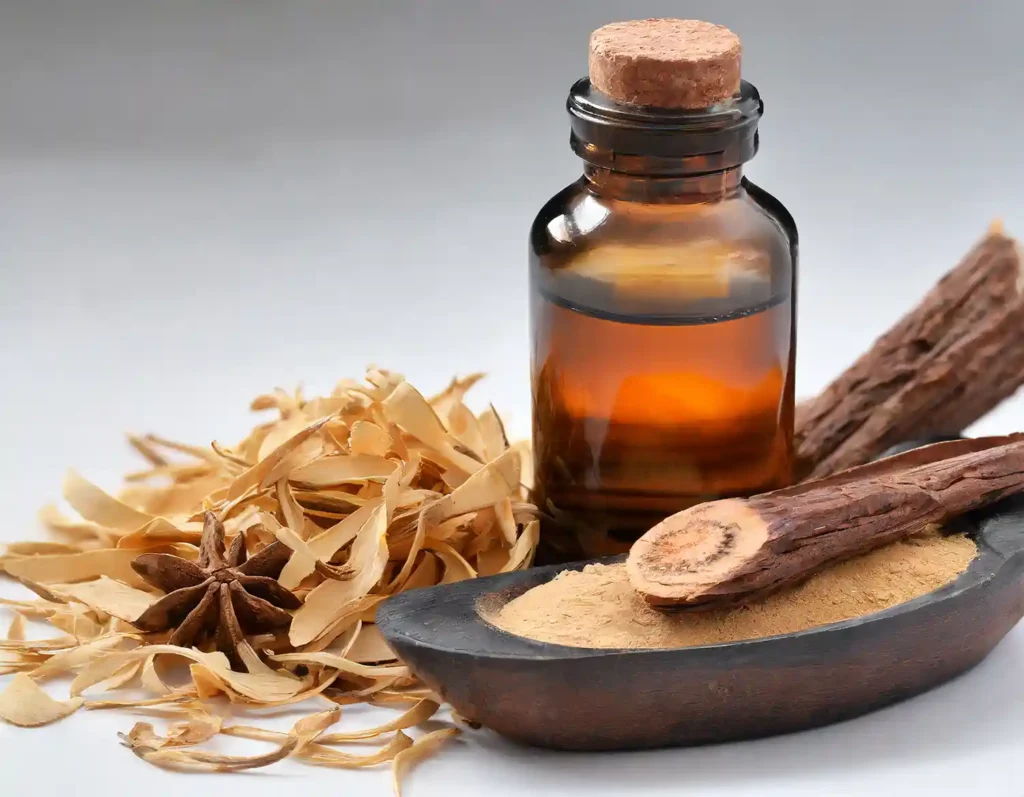
Sandalwood oil is extracted through a process of steam distillation, which involves passing steam through the wood chips of the sandalwood tree. The resulting oil is a pale yellow to golden yellow liquid with a distinctive woody and sweet aroma.
Sandalwood oil is known for its calming and grounding effects on the mind and body. It is used in aromatherapy to promote relaxation, reduce anxiety and stress, and improve mood. Sandalwood oil is also used in skincare and beauty products due to its anti-inflammatory, emollient, and antioxidant properties, where it is used to potentially help soothe and heal the skin, reduce the appearance of fine lines and wrinkles, and improve overall skin health.
Different types of sandalwood oil are available in the market, and their properties and benefits can vary depending on the species of sandalwood tree from which they are extracted. Indian sandalwood oil is known for its therapeutic properties and is commonly used in Ayurvedic medicine. Australian sandalwood oil is known for its anti-inflammatory and antimicrobial properties and is often used in skincare products.
Overall, sandalwood oil is a versatile and highly valued essential oil that has been used for centuries for its therapeutic and cosmetic properties. Its unique aroma and numerous benefits make it a popular ingredient in various products ranging from perfumes and soaps to skincare and beauty products.

Origins and Production
Sandalwood oil is extracted from the heartwood of sandalwood trees, primarily Santalum album (Indian sandalwood) and Santalum spicatum (Australian sandalwood). Sandalwood trees are medium-sized hemiparasitic trees indigenous to the tropical belt of peninsular India, Malay Archipelago, and northern Australia.
The production of sandalwood oil involves the process of steam distillation of the wood chips and billets. This process involves the use of steam to vaporise the essential oil from the wood chips and billets, which are then condensed to form the oil.
Sandalwood is one of the most valuable trees in the world, and its heartwood is treasured for its aroma. The heartwood of the tree is harvested for its oil, which is used in perfumes, cosmetics, and sacred unguents.
India is the largest producer and consumer of sandalwood oil, and the country has been using sandalwood for religious and medicinal purposes for over 4,000 years. In Australia, sandalwood is a significant export crop, and the country is the world’s largest producer of sustainable sandalwood.

Chemical Composition
Sandalwood oil is a complex mixture of various chemical compounds that contribute to its unique aroma and therapeutic properties. The main components of sandalwood oil are sesquiterpenic alcohols, particularly α-santalol and β-santalol, which together make up more than 70% of the oil’s composition.
The chemical composition of sandalwood oil can vary depending on the species, region grown, age of the tree, and the extraction process used.
α-santalol is the most abundant component of sandalwood oil, making up around 50-60% of the oil’s composition. This compound has been found to possess a range of therapeutic properties, including anti-inflammatory, anti-tumour, and antioxidant effects. α-santalol has also been shown to have potential as a natural insecticide and repellent.
β-santalol is the second most abundant component of sandalwood oil, comprising around 20-25% of the oil’s composition. This compound has similar therapeutic properties to α-santalol, including anti-inflammatory and antioxidant effects. β-santalol has also been found to have antimicrobial properties, making it useful for treating skin infections.
Sandalwood oil also contains other compounds that contribute to its therapeutic properties, including various antioxidants. Antioxidants are compounds that may neutralise free radicals, which are unstable molecules that can cause damage to cells and tissues.
By neutralising free radicals, antioxidants may help to protect the body against oxidative stress, which has been linked to a range of chronic health conditions, including cancer, heart disease, and Alzheimer’s disease.
Overall, the unique chemical composition of sandalwood oil makes it a valuable natural resource with a range of therapeutic properties. Its high content of α-santalol and β-santalol, combined with its antioxidant properties, make it a promising candidate for the development of new natural remedies and pharmaceuticals.

Aromatherapy and Meditation
Sandalwood oil has been used for centuries in aromatherapy and meditation practices due to its relaxing, calming, and grounding properties. The sweet, woody aroma of sandalwood is known to enhance mood and promote mental clarity. Incorporating sandalwood oil into meditation practice can have profound effects on overall well-being.
One popular way to use sandalwood oil in meditation is by diffusing it in a diffuser. The diffuser helps to spread the aroma throughout the room, creating a calming and relaxing atmosphere. Alternatively, sandalwood incense can be burned to achieve a similar effect.
Another way to use sandalwood oil in meditation is by applying it topically. A few drops of sandalwood oil can be mixed with a carrier oil and massaged onto the temples or the back of the neck to promote relaxation and calmness. A favourite blend of mine is Sandalwood, Neroli oil and Lavender essential oil.
Sandalwood oil can also be added to a bath to create a relaxing and grounding experience. A few drops of sandalwood oil can be added to bath salts and then dispersed into the bathwater to promote mental clarity and relaxation.
As we can see, it is a popular choice for aromatherapy and meditation due to its relaxing, calming, and grounding properties. Whether diffused, applied topically, or added to a bath, sandalwood oil can help enhance mood, promote mental clarity, and create a calming atmosphere.
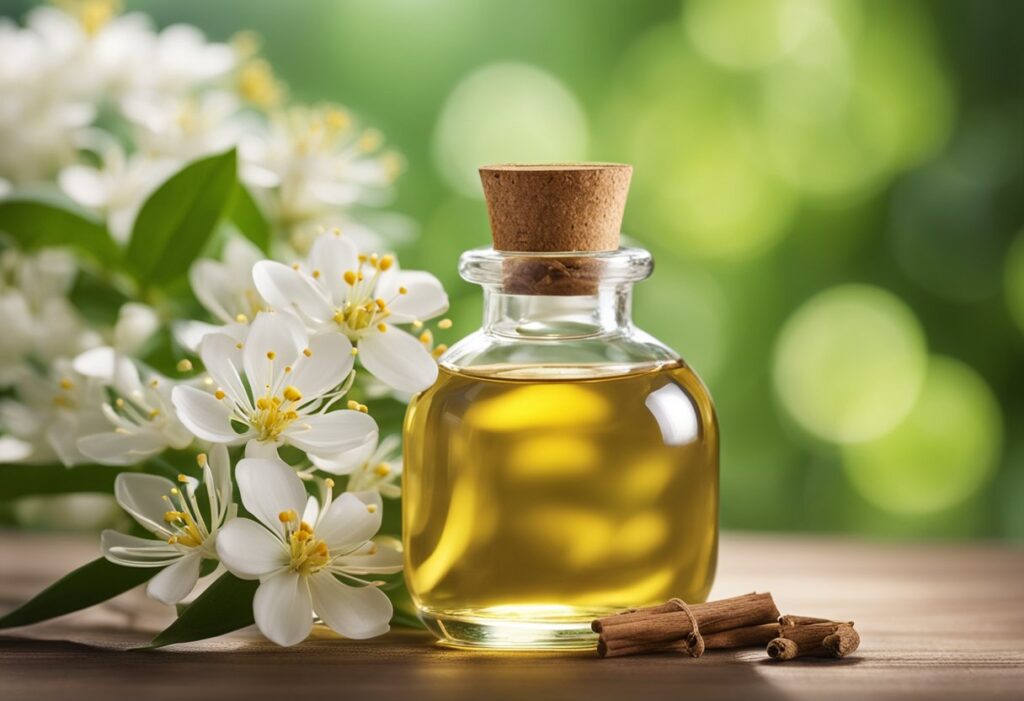
Benefits and Uses
Sandalwood oil has been used for centuries for its therapeutic benefits. It has a sweet, woody aroma that is known to promote relaxation and calmness.
Benefits
Sandalwood oil has several benefits, making it a popular choice in aromatherapy and alternative medicine. Some of the benefits of sandalwood oil include:
- Anti-inflammatory: Sandalwood oil has anti-inflammatory properties that make it effective in reducing inflammation and swelling. It is often used to help those coping with skin conditions like eczema and psoriasis.
- Anxiety and stress relief: The oil is known to have a calming effect on the mind and body. It can be helpful for some to reduce anxiety, stress, and tension and promote relaxation.
- Spiritual and emotional benefits: Sandalwood oil is often used in spiritual and religious ceremonies. It is believed to have a deeply grounding effect on the mind and body and promote spiritual awareness.
- Natural aphrodisiac: Sandalwood oil is considered to have aphrodisiac properties. It may help those coping with libido and encourage feelings of sensuality and intimacy.
Astringent: Sandalwood oil has astringent properties that make it effective in tightening and toning the skin. It is often used in skincare products to reduce the appearance of fine lines and wrinkles.
Tip… Add one drop of sandalwood oil to 10ml of your favourite unscented face cream for a wonderful treatment night cream.
Uses
Sandalwood oil has a wide range of uses in aromatherapy and alternative medicine. Some of the most common uses of sandalwood oil include:
- Antiviral and antiseptic: Sandalwood oil has antiviral and antiseptic properties, making it an effective choice for those coping with infections and wounds. It can be applied topically to minor scrapes, bruises, and other skin problems.
- Wound healing: Sandalwood oil is known to support the skin’s natural wound abilities.
- Therapeutic benefits: Sandalwood oil is often used in massage therapy to promote relaxation and relieve muscle tension. It can also be used in aromatic baths to promote relaxation and calmness.
In summary, sandalwood oil has several benefits and uses, making it a popular choice in aromatherapy and alternative medicine. Its anti-inflammatory, anxiety and stress-relieving, and astringent properties make it effective in treating a wide range of conditions. Its spiritual and emotional benefits, natural aphrodisiac properties, and therapeutic benefits make it a versatile and valuable oil in your collection.

In Cosmetics and Perfumery
Sandalwood oil is a popular ingredient in cosmetics and perfumery due to its woody aroma and warm, earthy scent. It is often used as a base note in perfumes, providing a long-lasting and rich foundation to a fragrance. In cosmetics, it is used in lotions and creams for its moisturising properties.
Sandalwood oil is also used in acne and skin care products due to its anti-inflammatory and antimicrobial properties. It may help soothe irritated skin and reduce the appearance of blemishes. It is also often used in eczema products and for other skin conditions due to its calming and healing properties.
In aftershave products, sandalwood oil is used for its soothing and antiseptic properties. It may help reduce irritation and redness caused by shaving, leaving the skin feeling fresh and smooth.
Sandalwood oil is a versatile ingredient in cosmetics and perfumery, providing benefits for both fragrance and skin care. Its unique aroma and therapeutic properties make it a popular choice for many beauty products.
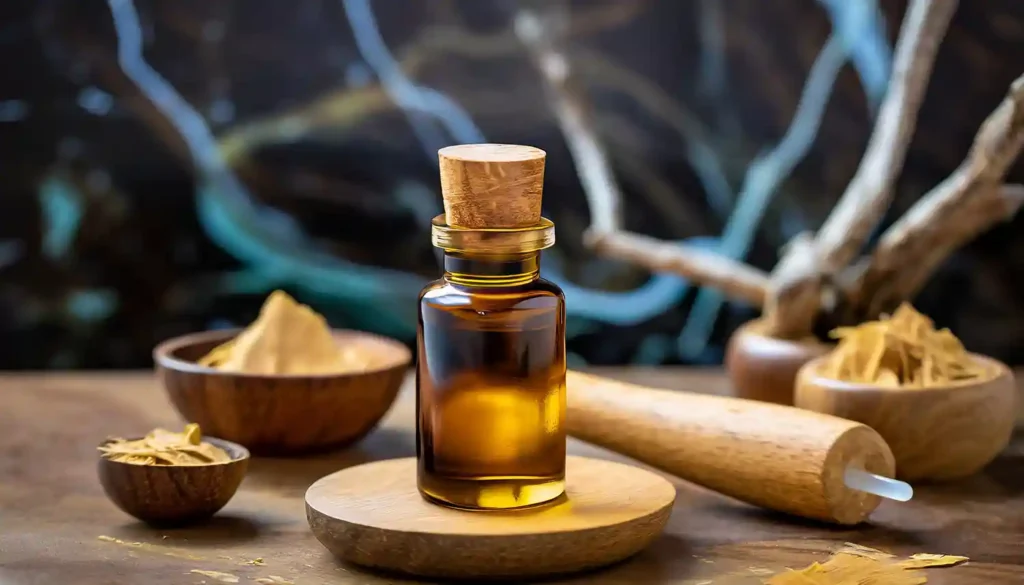
In Traditional Medicine
Sandalwood oil has been used in traditional medicine for centuries due to its various therapeutic properties. In Ayurvedic medicine, sandalwood oil is believed to have a calming effect on the mind and body, making it a popular choice for meditation and relaxation. It is also used as a natural remedy for anxiety and depression.
According to Chinese medicine, sandalwood oil is believed to have cooling properties that are considered to help alleviate symptoms of the common cold. It is also used to treat urinary tract infections and inflammation of the bronchi.
Sandalwood oil is also known for its skin-healing properties. In Ayurvedic medicine, it is used to treat various skin conditions such as eczema, psoriasis, and acne. It is also believed to potentially have anti-cancer properties.
While more research is needed to understand its therapeutic benefits fully, it remains a popular choice for those seeking natural remedies for various health problems.
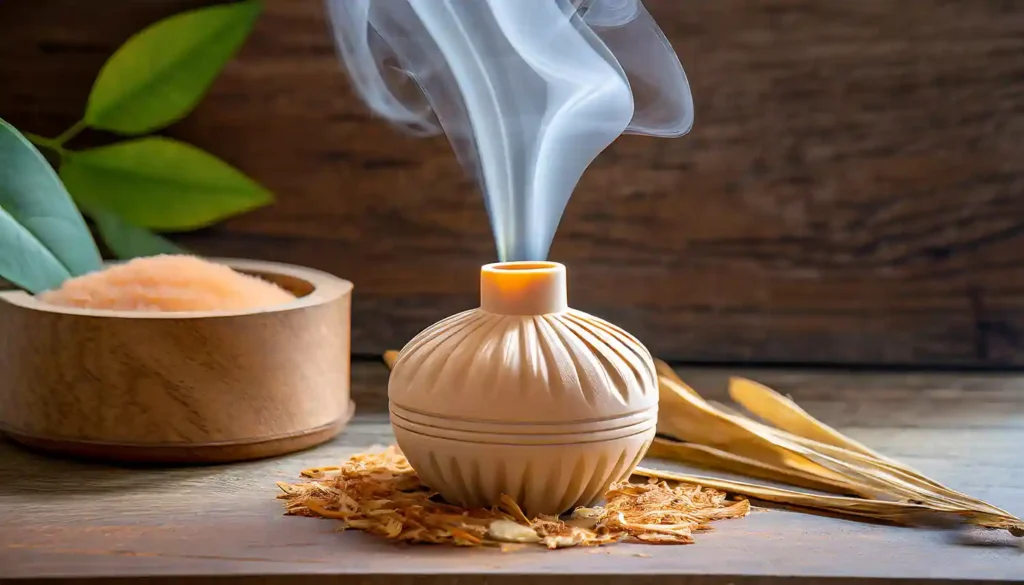
Safety and Precautions
Sandalwood oil has a long history of traditional use, but it is important to use it safely and with caution. Here are some safety and precautionary measures to keep in mind when using sandalwood oil:
Dilution with Carrier Oil
Sandalwood oil is a highly concentrated essential oil that should always be diluted with a carrier oil before it is used topically. Carrier oils such as coconut oil, jojoba oil, or almond oil can help to reduce the risk of skin irritation and allergic reactions. The recommended dilution ratio is up to 2 drops of sandalwood oil per 10ml carrier oil.
Patch Test
Before using sandalwood oil topically, it is recommended to perform a patch test to check for any allergic reactions or skin sensitivity. Apply a small amount of diluted oil to a small area of skin and wait for 24 hours to see if any adverse reactions occur.
Allergic Reactions
Although sandalwood oil is generally considered safe, some people may experience allergic reactions such as skin irritation, rash, or hives. If any of these symptoms occur, discontinue use immediately and seek medical attention if necessary.
Side Effects
Sandalwood oil is generally safe for most people when used correctly. It can be a valuable addition to your aromatherapy or skincare routine, but it is important to use it safely and with caution. Always dilute it with a carrier oil, perform a patch test, and be aware of any allergic reactions or side effects.
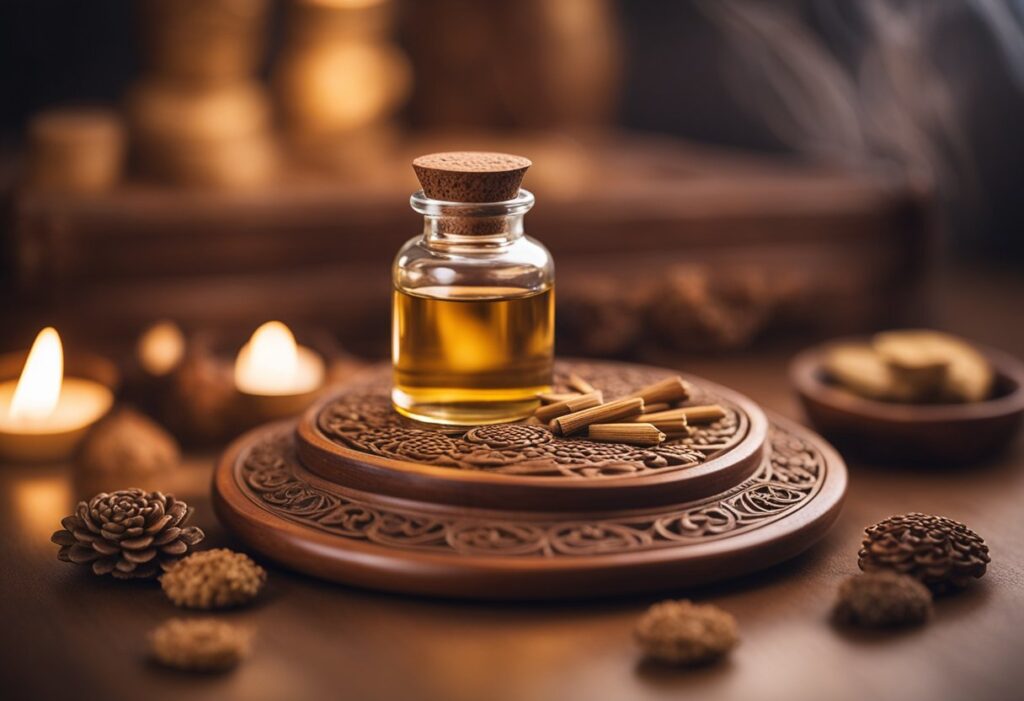
Cultural Significance
Sandalwood oil has been an important part of cultural and religious practices in many Eastern countries for centuries. It is considered holy and is often used in religious ceremonies, including weddings and births. Sandalwood’s significance in these ceremonies is due to its purity and calming properties.
In Hinduism, sandalwood paste is used during puja, a form of worship, to mark the forehead and other parts of the body. The paste is believed to have a cooling effect on the body and mind and is used to enhance meditation. Sandalwood is also used during wedding ceremonies in India, where it is applied to the bride and groom to signify their purity and enhance their beauty.
In addition to its use in religious ceremonies, sandalwood oil is also used in traditional medicine. In Ayurveda, an ancient Indian system of medicine, sandalwood oil is believed to have therapeutic properties ranging from antiseptic to anti-inflammatory. It is also believed to be a calming agent, assisting mental clarity and relaxation.
Sandalwood’s cultural significance extends beyond India. In Hawaii, sandalwood was once considered a sacred tree and was used in religious ceremonies. However, due to over-harvesting, the sandalwood tree is now endangered in Hawaii.
Overall, sandalwood oil’s cultural significance is rooted in its purity and calming properties. It has been used in religious ceremonies and traditional medicine for centuries and continues to be an important part of many Eastern cultures.
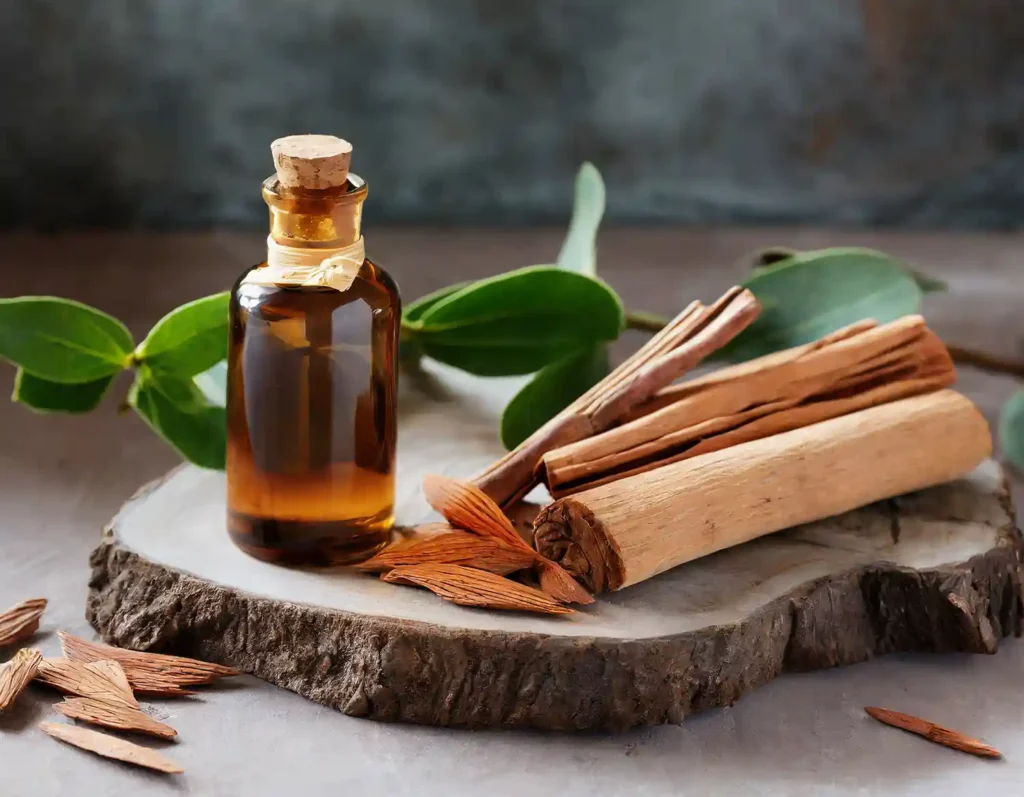
Frequently Asked Questions
What are the benefits of using Sandalwood Oil?
Sandalwood oil is known for its various benefits. It is commonly used in aromatherapy and skincare products. The oil has anti-inflammatory, antiseptic, and astringent properties that may help soothe the skin and reduce inflammation. It can also help reduce stress and anxiety levels, promote relaxation, and improve mental clarity.
What are the different ways to use Sandalwood Oil?
There are several ways to use Sandalwood Oil. It can be used topically by diluting it with a carrier oil and applying it directly to the skin. It can also be added to bath water, diffused into the air using a diffuser, or mixed with other oils to create a personalised fragrance.
Can Sandalwood Oil be used for skin care?
Yes, Sandalwood Oil can be used for skin care. It has anti-inflammatory properties that may help soothe the skin and reduce inflammation. It is also a natural astringent that can help tighten the skin and reduce the appearance of pores. Sandalwood Oil may also help reduce the signs of ageing and improve skin lustre.
What are the spiritual benefits of Sandalwood Oil?
Sandalwood Oil has been used for centuries in religious and spiritual practices. It is believed to have a calming effect on the mind and body and can help promote relaxation and meditation. Sandalwood Oil is also believed to have grounding properties and can help balance the chakras.
Is Sandalwood Oil good for hair?
Yes, Sandalwood Oil is good for the hair and scalp. It may help to soothe and condition the scalp, thus reducing dandruff and hair loss whilst improving hair texture. Sandalwood Oil can be added to hair oil or conditioner to reap its benefits.
What are the potential benefits of using Sandalwood Oil in aromatherapy?
Sandalwood Oil is commonly used in aromatherapy to promote relaxation and reduce stress and anxiety levels. It is also believed to have a grounding effect on the mind and body and can help improve mental clarity. Sandalwood Oil can be diffused into the air using a diffuser or added to a bath to create a relaxing atmosphere.





